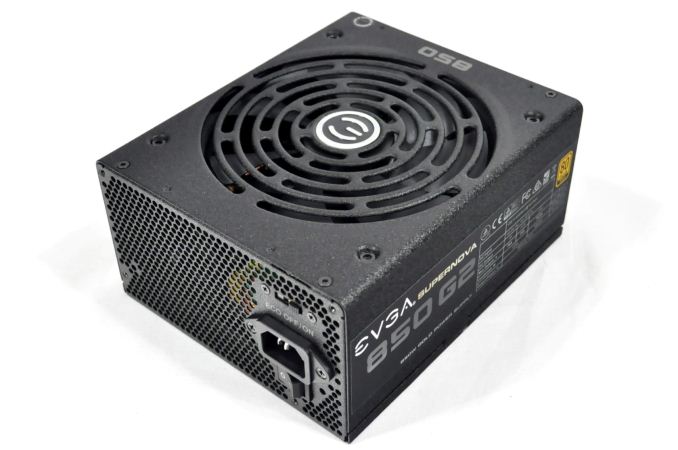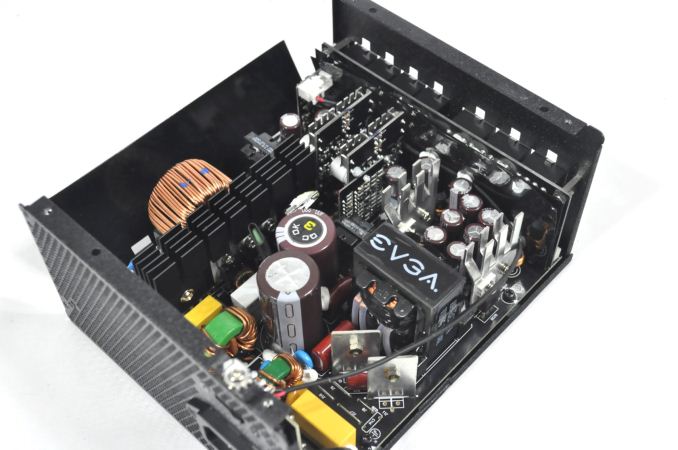EVGA Supernova 850 G2 Power Supply Review
by E. Fylladitakis on May 30, 2014 6:00 AM EST- Posted in
- Cases/Cooling/PSUs
- PSUs
- EVGA
- Super Flower
External Appearance
EVGA clearly made a serious effort to make the Supernova 850 G2 aesthetically unique. Instead of using a typical fan guard, the company went with a modified cover that has a circular-pattern opening integrated, as well as rounded edges. Stickers with the model and its specifications cover both sides of the chassis. The top side of the chassis is all clear, with the exception of two small stickers with the unit's serial and part numbers.
A textured, dark grey paint has been used for the entire unit. The chassis of the power supply is 180mm long, which could be a problem in tight mid-tower cases. As this is a fully modular unit, the front side is littered with the connectors for the cables. There is a legend indicating which connector goes where and we should note that the eight pin CPU connectors are different than the eight pin PCI Express connectors. The rear of the chassis is pretty much standard, with the exception of the "ECO on/off" switch that allows the user to switch between the standard and a more aggressive cooling profile.
Internal Design
EVGA installs a 140 mm dual ball bearing fan from Globe inside the Supernova 850 G2. Although this is a very powerful and notoriously loud model with a maximum speed of 1800 RPM, thankfully it will not even start when the unit is lightly loaded due to the smart "ECO" thermal control. The ECO fan control is based on temperature rather than load, starting the fan once the sensor reads a temperature of 55 °C and stopping it when the temperature drops below 45 °C.
EVGA entrusted the Supernova 850 G2 to Super Flower, a very reputable ODM of high performance PSUs. It is based on the Leadex platform, a design that became very popular for combining high performance and reliability at a reasonable cost.
The filtering stage of the unit is very basic, with two Y capacitors, two X capacitors and two filtering inductors on the main board. There is a small PCB behind the AC receptacle but it has no components soldered on it. Two extra Y capacitors can be found after the primary rectifying bridge, which is rather odd for a switching PSU. The primary rectifying bridge is mounted on the large black heatsink, alongside the active parts of the APFC circuit. As the rest of the heatsinks are much smaller, it can be clearly derived that the majority of the unit's losses originate before the primary inversion stage.
The passive components of the PFC are two Nippon Chemi-Con 330 μF capacitors and a large inductor. Nippon Chemi-Con supplies all of the smaller capacitors as well, electrolytic and polymer alike. Six transistors convert the main transformer's output to a single 12 Volt line and the lower voltage lines are being derived from it with DC to DC conversion circuits.
The assembly quality of the Supernova 850 G2 is very good, but not really perfect. There is enough glue to improve the mechanical cohesion of the unit but not really a lot of it on the large inductors, which can make this model prone to high frequency vibrations (coil whine noise). The soldering job is good, yet not textbook, with some crude joints and uneven use of solder.























22 Comments
View All Comments
Galatian - Friday, May 30, 2014 - link
Why so snark? At last try some constructive criticism.To the Author: a ATX power supply jumper is useful for example when you set up your water cooling loop and you need to bleed in first and to check if there are any leaks. Therefore you don't want the entire system to be powered on obviously.
JarredWalton - Friday, May 30, 2014 - link
Speaking as someone that has done plenty of time with Bitcoin and other cryptocurrencies -- and as the person that added that comment -- I can assure you that using it with BTC ASICs is indeed a plausible scenario, though perhaps becoming less so as everything moves to higher performance ASICs with built-in PSUs.patrickjchase - Friday, May 30, 2014 - link
An ATX P/S jumper is also useful if you want to power a storage enclosure.I use an 850W P/S in a Norco 4224 (4U rackmount case with 24 3.5" hot-swap bays) with an SAS expander in place of the motherboard.
Tunnah - Friday, May 30, 2014 - link
To the author of this comment: you do realise you sound like a complete and utter tool ? If you have something to add, add it, no need to be such a snarky git.bsim500 - Friday, May 30, 2014 - link
"EVGA 850w review, Corsair 1500w review, Corsair 1000w review, LEPA 1700w PSU coming soon", etc.All very nice, but for a change, given the increasing popularity of Mini-ITX, how about a low-end PSU series test of 60-360w PSU's for non-gamers/light gamers/HTPC/office box/net box, etc, that comprise the vast majority of general usage scenario's? I mean 60-160w pico-PSU plus maybe the Seasonic G360 (lowest wattage Gold rated full ATX)?
Removing the discrete GFX card from my main i5-3570 rig, it maxes out at all of 90w (exc monitor) 4T Prime load at 4GHz and idle's at a lowly 24w. An i3-based HTPC / office box typically draws 24-70w. Add a 7790 XBOne equivalent card, and it still barely pulls 120w max when gaming. Yet you wouldn't believe how many tech sites continue to test such usage scenarios with 800-1500w PSU's with low-watt efficiencies that are way down at 50-70%, which results in completely useless figures for the typical uses such machines are built for...
marc1000 - Friday, May 30, 2014 - link
I believe they already did one small-psu test over here, but I'm not able to find it now. google it around a bit.And I agree such big PSUs are not the best option currently. Of course for high-end gaming/computing it does make sense, but with midrange getting better and better each generation, we will soon have a hard time buying such power-hungry computers.
I myself use an i5+gtx660 and run a lot of games. Most of the time I'm limited by v-sync, and not the hardware. I'm not a professional, just play for fun, so no reason to upgrade. My system is powered by a simple 350w unit from Akasa - I'm living on the edge here, but it works: no bluescreens nor shutdowns nor performance hit.
DanNeely - Friday, May 30, 2014 - link
I'd like to see more small/mainstream PSU reviews too. The problem is that most hardware reviewed is whatever the OEMs are willing to provide; meaning there's a large bias towards halo devices over everything else.Death666Angel - Sunday, June 1, 2014 - link
Depends on wether or not people are interested in 120Hz gaming @ 1440p or even 60Hz @ 2160p. For that kind of stuff you need SLI/CF unless you - more or less drastically - reduce IQ.E.Fyll - Sunday, June 1, 2014 - link
True; most of our upcoming reviews will be of high output units. As mentioned, we are limited to what companies like to provide for testing and, for various reasons, every PR department likes to promote the best they have, even though it does not account for the majority of their revenue. This applies to virtually everything, from sewing needles to cars, not just PSUs. However, I have requested low output units from several manufacturers and some of them were positive, therefore we should be posting such reviews in the following months as well.teyink - Saturday, May 31, 2014 - link
Picked this up for $109.99 after rebate today.